

If you were to ask a child psychologist which character traits are most important for a child’s development, kindness and empathy would likely rank high on the list.
While many of a child’s everyday activities, such as playing, going to school, and interacting with caregivers, will provide natural opportunities to develop these critical traits, there is plenty we can do to proactively develop a child’s kindness and empathy.
Likewise, imagine how different classrooms, offices, organizations, and homes around the world might be if more adults stopped to consider how they might demonstrate more empathy and kindness in their regular interactions.
To this end, this article will walk you through a range of fun activities, exercises, and worksheets to help both children and adults develop the capacity for kindness and empathy in everyday life.
Kindness and empathy are important in fostering emotional intelligence. Before you read on, we thought you might like to download our three Emotional Intelligence Exercises for free. These science-based exercises will not only enhance your ability to understand and work with your emotions but will also give you the tools to foster the emotional intelligence of your clients, students or employees.
How do you teach something as important as kindness to children?
This likely sounds like a very daunting task. The good news is that kindness is a natural human response that likely won’t need much prodding or encouragement. However, it is something that should be practiced regularly to ensure that it will stick with kids throughout childhood and into adulthood.
Kindness can be taught at home or in the classroom, and preferably, it’s taught in both contexts.
There are many strategies for teaching kindness—far too many to include them all here—but below are six solid strategies to start with (Proud to be Primary, 2017).
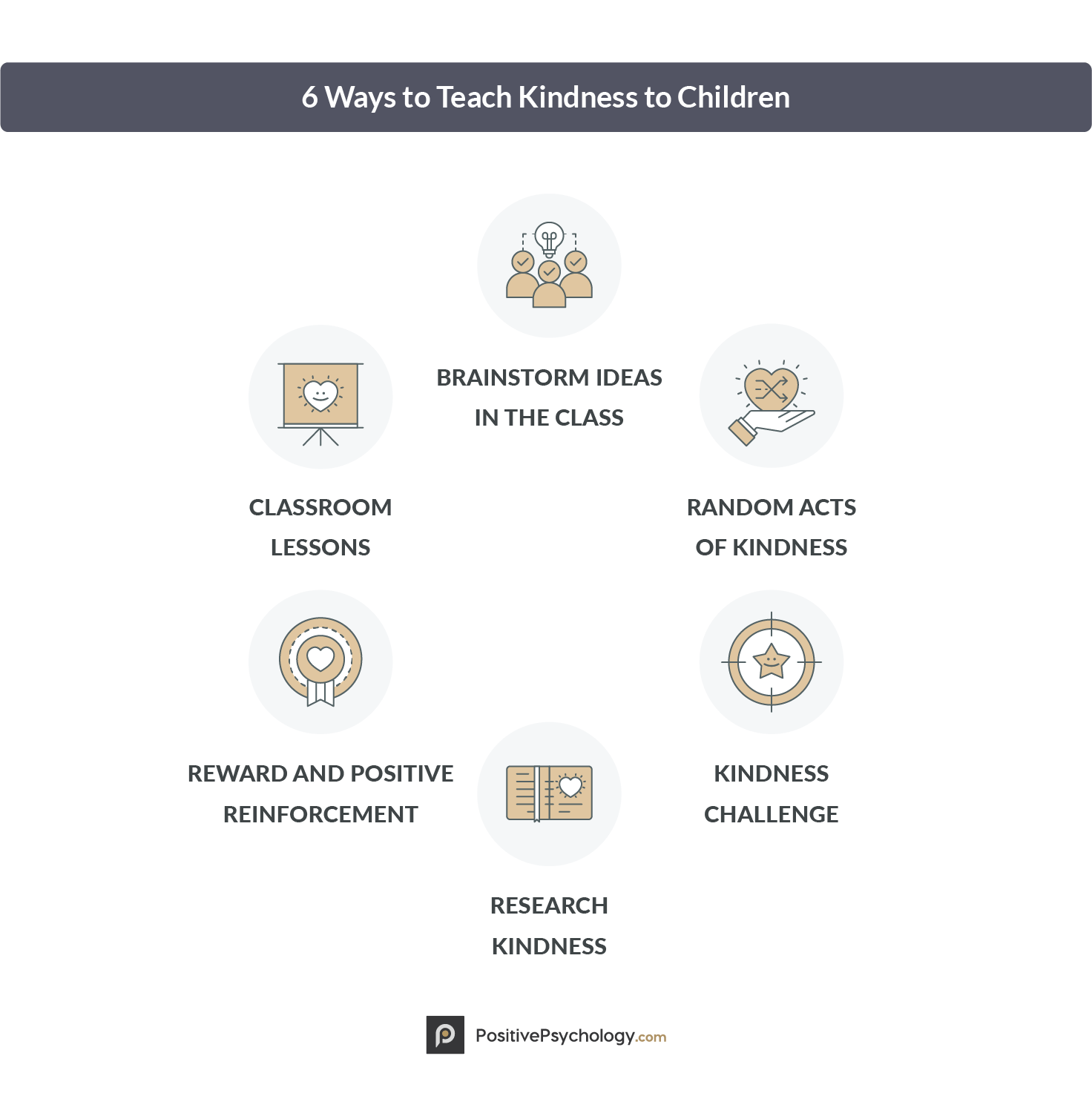
Children (and adults) are more likely to be engaged and involved in something they helped create or develop (Dirks, Cummings, & Pierce, 1996). With this concept in mind, brainstorming ideas on how to be kind as a class should instill a sense of ownership in kids that helps them feel excited about practicing kindness.
You can brainstorm as a large group with open-ended questions like, “What was something kind you saw someone do lately—big or small?” Write down the students’ responses on a whiteboard or chalkboard and break them into two categories (big vs. small), but be sure to emphasize the importance of small acts of kindness in addition to grand gestures.
You can also have students brainstorm independently by passing out a notecard to each child and instructing the students to write down something nice that someone else did for them lately and how it made them feel. Once the students are done, collect the notecards and read them aloud in order to help the students understand acts of kindness.
Once students understand what acts of kindness are, introduce them to the idea of random acts of kindness. Sharing this idea with students can encourage them to show kindness to their friends and families in unexpected ways.
One method is to use complimentary notes or positive sticky notes. Provide the class with a supply of sticky notes and explain that anyone can take a sticky note at any time and write down a compliment for another student. They should sneak the sticky note onto that student’s desk when he or she is not looking to make it truly random and fun.
Another method is to use thank-you notes. Give your students some time to write down their appreciation for someone who recently did something nice for them, and encourage them to deliver their notes as soon as they can.
Challenging your students to a competition can be an effective motivator for increasing kindness. In this challenge, students will recognize when someone does something nice for them unexpectedly and surprise others with random acts of kindness themselves.
Give the students a goal to meet, such as performing three kind acts per week or noticing five kind acts per week. To keep them excited about the challenge, give them star stickers to add to a classroom chart or a paper cutout to stick on a bulletin board when they meet their goal.
While you are encouraging students to be kinder to others, make sure to practice some kindness yourself. Give each student at least one compliment before the end of the day. Before letting your students go for the day, tell them that you purposely complimented each of them during the day and that you noticed a positive change in the classroom mood.
Explain that these positive changes are common outcomes of practicing kindness.
Depending on how old your students are, you might want to read them one of these age-appropriate books about practicing kindness.
For kindergarteners to second-graders, Nancy Elizabeth Wallace’s The Kindness Quilt is a good book to read and discuss.
For more advanced readers, Carol McCloud’s Have You Filled a Bucket Today? will teach students the idea that everyone carries an invisible bucket that can be filled with compliments and kindness.
Classroom lessons on kindness can also have a big impact on how kind students tend to be. There are many lessons out there of various lengths that utilize different methods of teaching kindness.
For ideas on how to incorporate classroom lessons on kindness into your teaching, the Random Acts of Kindness Foundation has several useful lesson plans and curriculums targeted toward a range of different year and age groups on their website.
Finally, you can use rewards and positive reinforcement to encourage more kindness in the classroom. This can be as simple as a moment of praise or a sticker, or something more personal like a kindness card or a certificate of kindness.
You can even recruit the other students to help you pass out rewards for students caught being kind.
Many of these can be adapted for use in the home as well as the classroom.
However, the most important thing to remember when it comes to teaching kindness is to model the behavior you hope to see in the children—be kind yourself, and they will be more likely to mirror that kindness (Radke-Yarrow & Zahn-Waxler, 1984).
A quick Google search will reveal dozens, if not hundreds, of kindness activities for children and students. We’ve listed some of our favorites below.
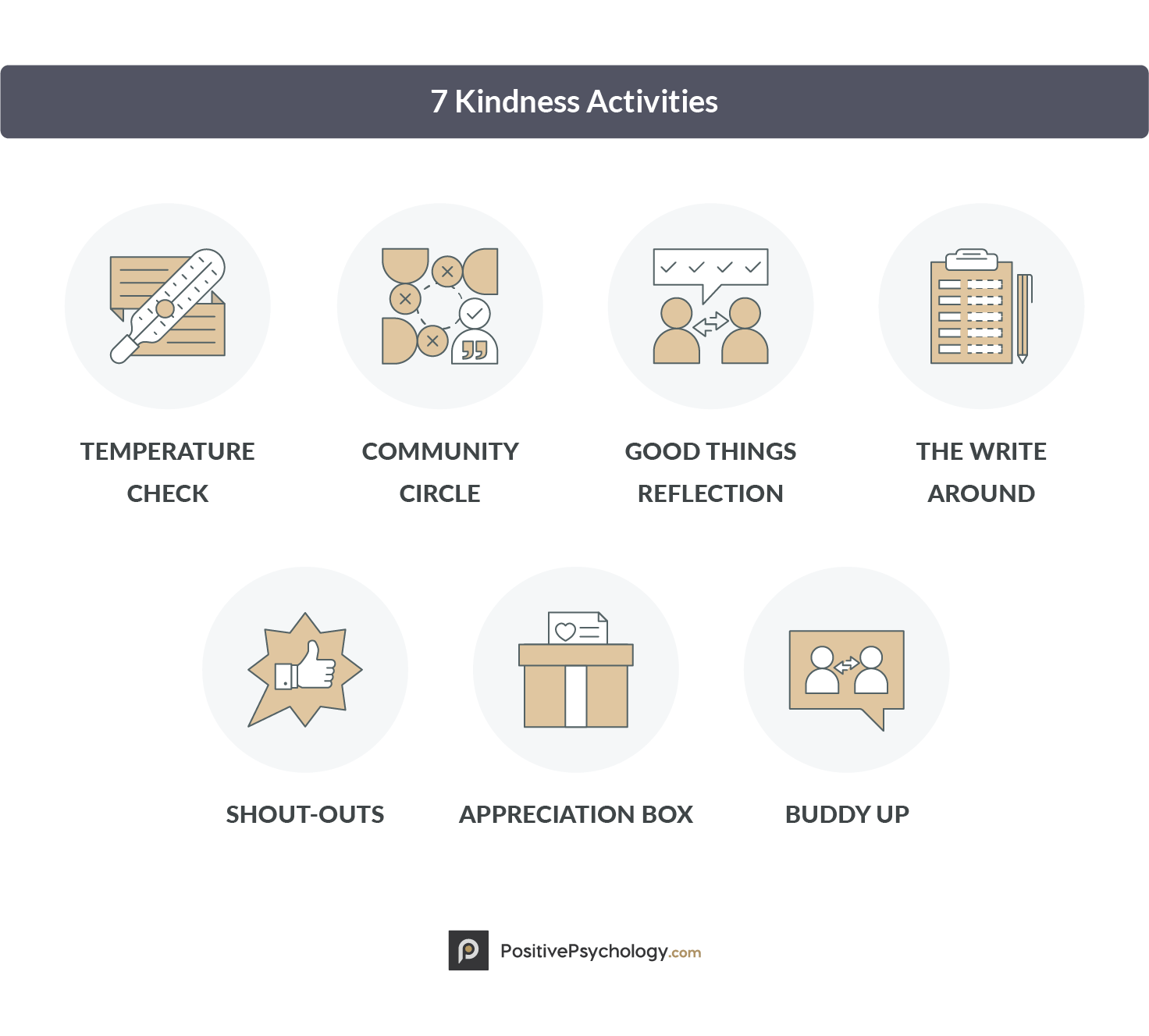
How Are You? is a very simple activity, but its potential to encourage a positive emotional state should not be underestimated. Integrating it into your lessons is as easy as asking a single question at the beginning of class:
“How are you feeling today?”
Not only will this let the students know that someone cares about how they are feeling, but it also signals to them that sometimes they’ll be feeling something negative—and that there’s nothing wrong with that.
We can all use this reminder that we are human and are all subject to emotions and feelings that we’d rather not have.
This reminder can be especially helpful for teenagers, who are likely dealing with more intense and varied emotions than people of other age groups.
After asking this question, you can instruct students to turn and talk to their neighbor, or share with the whole class.
Starting the day with this activity can get students in the right frame of mind to be more kind and empathetic towards one another, and it can alert you to potential problems with specific students.
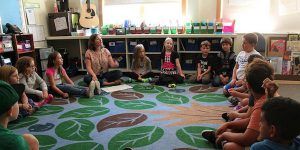
Another valuable activity to encourage good listening skills and empathy is the Group Circle.
Before beginning this activity, choose a “talking piece”—this is an object that is passed around the group and signals that the holder has exclusive speaking rights. You can use a stuffed animal, a small beach ball, or any object that is easy to hold and pass around.
If you can, remove the desks or tables from the classroom. If this is not possible, you can either push the desks and chairs to the perimeter of the room, arrange the chairs in a circle, or sit on the floor with the whole class.
Tell your students that in the Group Circle, only one person may talk at a time and everyone else must listen quietly and respectfully.
Show the class the talking piece and explain that only the individual holding the talking piece may speak.
This activity can be a good way to start the day, end the day, or simply encourage community and kindness at any time.
It is especially useful after something particularly emotional or traumatic happens, whether that event took place in the classroom, in your city, or on another continent.
The Group Circle exercise helps students relate to one another, and it can encourage students to accept and share feelings that may be difficult to talk about. This lesson outline also contains tips and suggestions to help you get started.
This is a quick and easy activity you can try with children of nearly any age. It’s an especially good idea to use this positive, mood-boosting activity to start class (or your day, if you’re at home).
Instruct each student to turn to one of their neighbors and tell him or her something good. Specifically, you can have them finish one of these positive “talking stems,” or prompts:
Encourage the kids to be creative with their “nice thing,” but if they’re having trouble coming up with something, assure them that the nice thing can be as small as eating something they liked for dinner last night.
Once all students have shared a nice thing with their partners, open it up to the entire classroom. Ask for volunteers who would like to share their nice thing with the class, or volunteers who have given their neighbors permission to share their nice things for them.
This is an excellent activity to get kids in a positive mood, and it’s appropriate for kids of all ages—even teenagers can find at least one good thing in their lives.
Sharing the nice thing will put the students in a more positive frame of mind, and sharing something personal and positive with others will make them feel heard and affirmed by others.

If you’re more interested in getting kids writing than talking, this is a similar activity that can get everyone in a more positive mood.
Given the nature of the silent appreciation activity, it will only be suitable for classes where everyone has at least some writing ability—so it likely won’t work for a classroom of preschoolers.
First, you will need to put together a handout with sentence stems (or prompts) on it:
Make sure to leave plenty of room for students to finish these sentences, especially if they are younger writers. Next, pass out the handouts and ask each student to write only their name at the top of the paper.
Collect the handouts and pass them out once again, randomly this time.
Make sure each student received a different student’s handout.
Instruct the students to be silent for a few minutes while they write something about the person whose handout they received. They can respond to just one sentence stem or several if they have more good things to say about the person.
After the few minutes are up, have each student pass the handout to another student (not the handout’s owner, yet).
Encourage the students to complete whichever sentence stem calls to them, whether another student has completed it or not.
After doing a few rounds of this, pass all of the papers back to their owners and give them a chance to read all of the nice things their peers have written about them.
If you’d like to continue the positivity, you can ask for volunteers to share one or two of the nice things on their handout. It will make the reader feel good, the writer feels good, and encourage everyone to be a little more positive.
Another activity that can help students practice their writing while injecting a little positivity into the classroom is called Thank You Post.
First, create a “postbox” to leave in the back of the classroom. This can be an opportunity to get creative and make a postbox that reflects the class, or you can have the class help you create the box. For example, you could have the class vote on a theme for the postbox, or each student could pick out one small space on it to decorate however he or she would like.
Wherever you place the postbox, make sure to leave small slips of paper or sticky notes nearby.
Tell students that they can use the box to write down positive messages, thank-you notes, or messages of appreciation or encouragement to their fellow students or the teacher, teaching assistant, or another adult in the classroom.
The students may need some examples of what to write. Model what a good appreciation message sounds like by reading a few sample messages out loud with the class.
You have a couple of options when it comes to reading the notes of appreciation:
You can choose any of these methods or create your own method that works for your class. The important thing is that each student should eventually get to hear or read a note of thanks or appreciation that someone has written about him or her.
This activity encourages students to be kind to one another and to be on the lookout for positive things to write down and slip into the Thank You Post.
If you have a particularly chatty class or a class that hasn’t mastered writing yet, this Here’s To… activity can be a good substitute for the Thank You Post.
Your students will likely need some modeling to get comfortable with this activity, especially if you have a lot of shy kids in your class. Plan at least a couple of weeks of modeling these mini “toasts” before encouraging your students to join in.
There are many ways to start a Here’s To (Student) toast, but three positive sentence stems might include:
Use sentiments like these to thank students for their contributions, praise them for a job well-done, or call out an act of kindness.
Eventually, your students may pick up on what you’re doing and start making their own Here’s To… toasts. However, you may need to specifically encourage them to join you in calling out fellow students for praise or thanks.
This activity can be a great way to end the day. Spending just a few minutes on it at the end of class can boost everyone’s mood, give students a chance to publicly appreciate one another, and send students home riding a wave of positivity and kindness.

This fun and easy activity will encourage your students to help one another.
It’s as simple as assigning each student a partner—you can let the students pick their own partners, you can choose a companion for them, or you can alternate between both methods.
If your students tend to stick with their existing friend groups or cliques, assigning a buddy rather than letting them choose may be more effective.
You don’t have to use the word “partner”; instead, pick a word that fits well with your class’s interests.
If you have a lot of young kids who aspire to become pilots, you can use the term “copilot.” If your classroom is an older one with a good sense of humor, you can say they’ll pair up with a “wingman” or “wingwoman.”
Whatever terminology you choose, the activity is the same—students will work with their partners and turn to their partners first when they need help.
For example, if a student missed a day of class and needs copies of handouts or lecture notes, she should first ask her partner.
Or, if a student is having trouble with a concept that’s being taught, he should first check in with his partner to see whether he or she can explain it before asking another person.
You’ve probably noticed a theme—whatever issue or problem a student is having (unless it’s an emergency), he or she should first work one-on-one with a partner to attempt to solve it. If that fails, the student can ask the teacher.
To make sure students get a chance to work on their relationship skills with a wide range of people and personalities, have them switch buddies regularly. They can find a new partner each week, every other week, every month, or any period of time that works for your class.
This activity will give your students ample opportunity to build communication skills, practice accountability, and be kind to one another.

These detailed, science-based exercises will help you or your clients understand and use emotions advantageously.
Download PDF
By filling out your name and email address below.

Have you ever heard of World Kindness Day?
It’s an international day of kindness recognized by countries around the world that encourages everyone to look beyond the boundaries of race, religion, and politics and to appreciate the humanity in all of us.
World Kindness Day is the perfect time to practice kindness, whether it’s toward family members, friends, coworkers, or strangers.
While many of the activities and exercises are perfect for World Kindness Day, the Random Acts of Kindness Foundation also has a list of 10 easy activities you can do to celebrate the holiday.
The activities are:
If that’s not enough for you, here are five more ideas from The Random Acts of Kindness Foundation (2016):
For more ideas on how to celebrate World Kindness Day with random acts of kindness, take a look at the many ideas listed on the Random Acts of Kindness website.
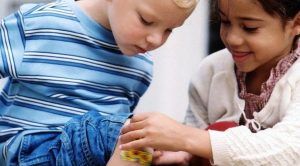
There are also many ways to teach empathy to children, a construct that’s similar to yet distinct from kindness.
While kindness involves acts of goodwill, smiles, and positive words, empathy is about earnest listening, relating to one another, and putting yourself in someone else’s shoes (Hall, Schwartz, & Duong, 2021).
There are many ways to introduce, discuss, and encourage empathy in the classroom, including tackling empathy directly by including it in the curriculum (Crowley & Saide, 2016).
For example, if you teach language arts, have the class define empathy and identify characters in literature that demonstrate empathy. Or, if you teach public speaking, highlight the importance of empathizing with one’s audience—students should think about who their audience is and how to best relate to that audience before stepping to the podium.
You could also take some concrete steps to inject your classroom with a culture of empathy, steps like (Crowley & Saide, 2016):

Just as modeling kindness is vital to teaching the concept to students, so is modeling empathy. The most important thing you can do to encourage empathy in your students is to use empathy yourself, whether with your students, other teachers, or even with fictional characters.
Show your students how to be empathetic towards others, even if you don’t agree with that person or are not necessarily sympathetic towards them.
As noted earlier, it is vital to start teaching kindness and empathy early on, but adults are also capable of increasing their capacity for empathy. The following resource is a good source of information on teaching empathy to adults:

The Positive Psychology Toolkit© is a groundbreaking practitioner resource containing over 500 science-based exercises, activities, interventions, questionnaires, and assessments created by experts using the latest positive psychology research.
Updated monthly. 100% Science-based.
“The best positive psychology resource out there!”
— Emiliya Zhivotovskaya, Flourishing Center CEO
While it’s important to instill kindness and empathy as early as possible, it’s never too late to learn how to be more empathetic. There are many worksheets and activities for students, adolescents, and adults to enhance their capacity for empathy.
Below is a list of some worksheets and exercises that work well for students and adults.
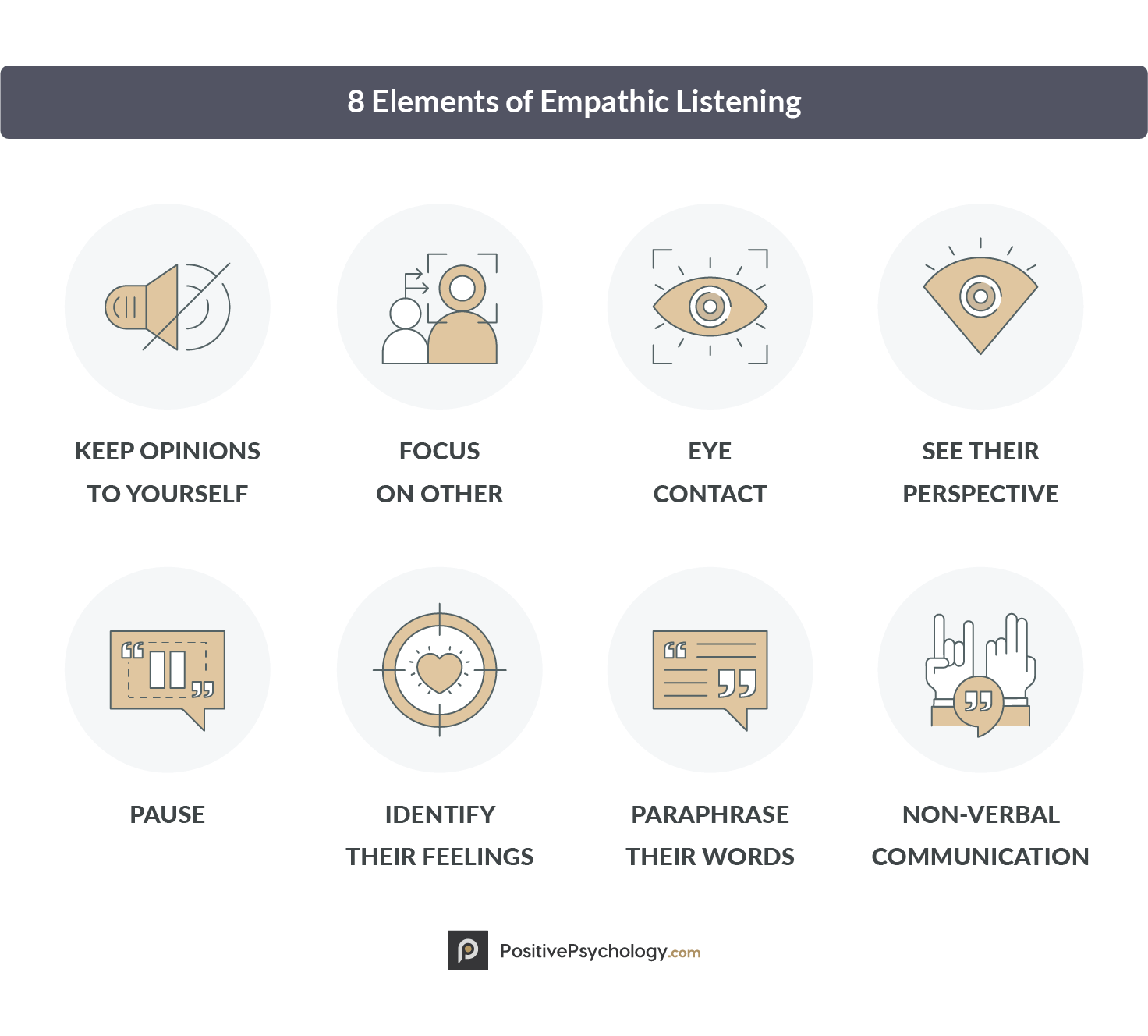
This is a very useful exercise that can encourage empathy in people of all ages. Therapists are advised to begin with an explanation of what empathetic listening involves – use these main elements to give a good flavor for the approach as a whole:
Listening might sound like an easy thing to do, but there is a big difference between listening without paying much attention and active listening (Robertson, 2005). Active listening is the best way to connect with another person and is vital for healthy relationships.
The second part of this worksheet takes this general description of active listening and encourages you to apply it in your life.
Step One is Practicing Pausing/Wait Time, and it works well with subgroups of three people if you are working with a larger group. Once participants are in triads, each will have a distinct role:
Some of the key benefits of this exercise are also found in reflecting on the activity after each participant has had a turn at each role. Prompts for discussion include:
There are a further two parts to this exercise – Practice Paraphrasing, and Reflecting Feelings. Together, they offer a valuable and comprehensive approach to honing the Empathic Techniques introduced above.
If this exercise interests you, here are a further five steps to practicing empathic listening in a real-life situation:
The full worksheet is available as part of a subscription to the Positive Psychology Toolkit©, however this shortened version – Listening Accurately Worksheet – is available for download.

This worksheet can be completed individually or in a group setting. It requires some preparation, but it can be extremely helpful in differentiating between empathy and other responses.
Print out the handout found on the last page of this Empathy Bingo PDF, or copy the words to pieces of paper. The twelve squares should read:
If you’re leading a group through this exercise, you can simply read through the dialogue between two people (labeled “A” and “B”) and instruct the group to decide which square corresponds with which conversation.
If you’re working through this worksheet on your own, have a friend write down the dialogues on a separate sheet of paper (so you don’t inadvertently see the correct pairings) and work through the activity by matching the reactions to the conversations.
The dialogues include back-and-forths such as:
A: I’m worried about having enough money to pay my bills this month.
B: I’ll loan you the money.
A: Look at my scar from the cycling accident.
B: That’s nothing, you should see the one I have on my knee.
A: I got caught in traffic for two hours in 100-degree weather and no air conditioning.
B: That reminds me of the time . . .
As you can see, each of these dialogues displays a reaction we may have when someone shares with us.
None of the three examples included here showcase empathy, but each dialogue models a particular type of reaction so that you have a chance to see them in action.
In case you’re wondering, the first dialogue corresponds to “Fixing It,” the second corresponds to “One-Upping,” and the third corresponds to “Storytelling.”
This exercise can help you or a group learn about the different ways we can respond to a friend in need of empathy, and why empathy is usually the best choice.
This empathy worksheet is great for students and younger children due to the simple language and child-oriented depictions of empathy, but the message of this worksheet can be useful for older students and adults as well.
Completing this worksheet will help students learn what empathy is, how to spot empathy, how to practice empathy, and why it’s important.
The handout offers the following description of empathy:
“Empathy is understanding and caring about what other people are feeling.
It is about putting yourself in their position so you can feel the same way as them. If another kid’s balloon blows away, you may empathize with him because you can understand his feeling of sadness.
Maybe, you might also feel a bit sad too. Feeling happy, sad, or another way because someone else does is empathy.”
After this definition of empathy, the second page provides space for the student to answer some prompts that will get him or her thinking about empathy.
These questions/prompts are:
Responding to these prompts will encourage students to think of themselves as capable of empathizing with others, to think about how to practice empathy going forward, and to think critically about why empathy is so important.